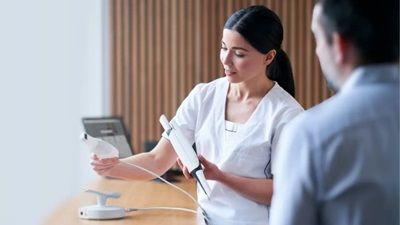- Home
- Blog
- Digital dentistry
- Prepare for intraoral scanner ...
How to prepare for an intraoral scanner demo
Are you ready to go digital with your impressions? Here’s how to prepare for that moment when the sales rep comes into your office to show you all the great stuff their scanner can do.
Step 1: Appoint the right person (the one making the decision)
As a former 3Shape Academy instructor, I used to do demos for 3Shape end customers. I found that it was always best if the decision-maker in the practice and I did the demo one-on-one.
If the dentist is the decision-maker, that person needs to block out enough time to concentrate on the demo. There should be no interruptions or staff to influence the decision because you need to get a good look and feel for the scanner during the meeting. You can always bring the team in later.
It is best if the decision-maker at the practice makes the final call on whether they want to invest in a scanner and if it’s considered an asset to the practice and staff.
Step 2: Talk to your dental lab and ask for their advice
Before you even book a demo with a potential manufacturer, you should speak with your lab. They probably work with scans from multiple intraoral scanner makers and have their favorite brands and recommendations about which brands come with which benefits.
Your lab can also tell you about the workflow, sending files, communications, and how to best prep for scans.
Step 3: Think about your expectations on look and feel of an intraoral scanner
 One of the most critical requirements when demoing a scanner is to touch and hold the scanner.
One of the most critical requirements when demoing a scanner is to touch and hold the scanner.
It is a new tool, and you need to know whether you could see yourself adopting this new technology.
After all, you and your team will use the scanner routinely. You should evaluate the scanner like you would a car.
In this light, it is vital to know beforehand whether you expect to test ride an Audi or a Ford.
Check its shape, its lines, and kick the tires. How does it feel? Is it solid? Does it feel like a toy? Test drive it like a car.
You want to feel the scanner's maneuverability, its ergonomics.
You want a scanner that looks and feels good in your office because having one will impress your patients and help get in referrals via existing patients, as Dr. Naren Rajan outlines.
Step 4: Bring some dental models (and real people) you’d like to test scanning on
When I did demos, I would first scan a few models with the decision-maker. I always tried to use dental models from the clinic, although I had my own with me.
I then wanted them to try and scan me. The models are great, but to understand a scanner, you need to demo it on a real person.
When doing the demo, you should expect to learn about scan strategies, dental software, and where and how you use the scanner (its application). You'll also need to pay attention to its scanning speed, how fast it scans, and what are the contributing factors for getting a perfect scan, like the setup, integrations, sterilization protocols, and IT requirements.
Step 5: Create a ranking list of these big 6 factors
Here’s the BIG 6 you will need to have a solid opinion on before you can make an informed decision.

- Hardware – how sleek and appealing is the scanner?
- Software – is it easy to understand?
- Treatments – can it -easily- facilitate the treatments you provide or plan to provide?
- Ergonomics – is it easy to use?
- How fast and efficiently can it scan?
- How well does the scanner capture images, and do the colors look good on the screen?
Accuracy is essential but difficult to discern in a demo situation. Reference clinical studies or speak with your lab partner.
Step 6: Ask verifying questions going into the nitty-gritty details
Depending on whether you’re looking at purchasing your first scanner or you’re a veteran, looking for a new model or second scanner, you must get specific information about the scanner during the demo.
Additional questions that you need answers to are:
- What does the scanner come with, physically and software-wise?
- Does the manufacturer or reseller include digital dentistry training?
- Is there a service agreement?
- How is support included? All-in or pay per case?
- Is there warranty in case something happens?
- Are scanner tips and batteries included?
One of my colleagues wrote a blog post outlining in more detail which questions to ask the sales rep, and why, and made a practical handout for it that you can download for free.
If you have previously worked with intraoral scanners, use the demo session to compare its feel, weight, length, and usability with your other scanner. Check the speed and how it captures margins; you probably know what to look for. As a dentist used to digital workflows, you'll also want to know more about the software, integrations, file sending, and storage. Discuss the IT setup, which I'll explore later in this post.
If you are new to intraoral scanning, it's about feeling the scanner and, as mentioned, seeing if you can envision it in your practice. Find out what types of support and educational opportunities are available, and if they have a customer care program that can help you with professional training, one-to-one consultation, and online learning resources.
Step 7: Put on your IT hat to ensure you understand the technicalities
One of the great things about digital dental workflows is their speed and optimized communications. Depending on the IOS brand, you can review design proposals from your lab on your phone, discuss changes with chat, or make notes on the treatment proposals. It is incredibly efficient.
However, your practice needs a proper IT setup to take advantage of this. There are many ways to set up your practice. But the basic idea is that you want to be able to send your scans anywhere you want. And you want to access files and, i.e., treatment software from various PCs in your practice.
I won't go into all the details, but here are some questions you will likely want to know more about during or after a demo:
- Where are my scans stored?
- How do I share them with treatment partners or throughout the clinic?
- How do I bring them into my design software, send them to a mill or printer - if relevant?
- What's communication like or the sending of files to my lab?
- Do I need a particular IT setup for my practice: Wi-Fi, client-server setup, TRIOS Share type solution?
Conclusion
In short, to have a great intraoral scanner demo, you need to prepare. Remember to focus on critical aspects like scanner feel, usability, image quality, and software simplicity when testing the scanner, but don’t forget topics like support, training and service.
Following the above will help you make an informed decision and get the most out of your demo.
- Home
- Blog
- Digital dentistry
- Prepare for intraoral scanner ...
